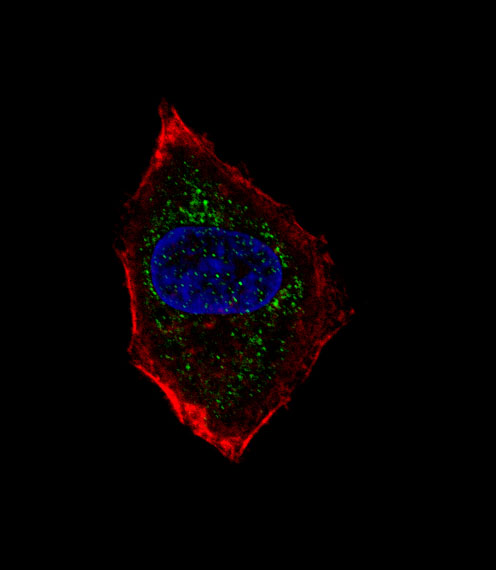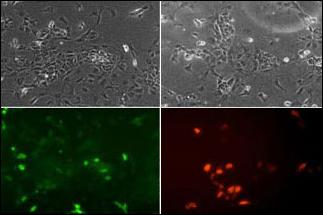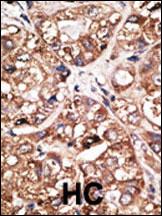NeuroD1 Antibody (N-term)
Purified Rabbit Polyclonal Antibody (Pab)
- SPECIFICATION
- CITATIONS
- PROTOCOLS
- BACKGROUND

Application
| IF, IHC-P, WB, E |
|---|---|
| Primary Accession | Q13562 |
| Reactivity | Human |
| Host | Rabbit |
| Clonality | Polyclonal |
| Isotype | Rabbit IgG |
| Calculated MW | 39920 Da |
| Antigen Region | 15-45 aa |
| Gene ID | 4760 |
|---|---|
| Other Names | Neurogenic differentiation factor 1, NeuroD, NeuroD1, Class A basic helix-loop-helix protein 3, bHLHa3, NEUROD1, BHLHA3, NEUROD |
| Target/Specificity | This NeuroD1 antibody is generated from rabbits immunized with a KLH conjugated synthetic peptide between 15-45 amino acids from the N-terminal region of human NeuroD1. |
| Dilution | IF~~1:100 IHC-P~~1:50~100 WB~~1:1000 E~~Use at an assay dependent concentration. |
| Format | Purified polyclonal antibody supplied in PBS with 0.09% (W/V) sodium azide. This antibody is prepared by Saturated Ammonium Sulfate (SAS) precipitation followed by dialysis against PBS. |
| Storage | Maintain refrigerated at 2-8°C for up to 2 weeks. For long term storage store at -20°C in small aliquots to prevent freeze-thaw cycles. |
| Precautions | NeuroD1 Antibody (N-term) is for research use only and not for use in diagnostic or therapeutic procedures. |
| Name | NEUROD1 |
|---|---|
| Synonyms | BHLHA3, NEUROD |
| Function | Acts as a transcriptional activator: mediates transcriptional activation by binding to E box-containing promoter consensus core sequences 5'-CANNTG-3'. Associates with the p300/CBP transcription coactivator complex to stimulate transcription of the secretin gene as well as the gene encoding the cyclin-dependent kinase inhibitor CDKN1A. Contributes to the regulation of several cell differentiation pathways, like those that promote the formation of early retinal ganglion cells, inner ear sensory neurons, granule cells forming either the cerebellum or the dentate gyrus cell layer of the hippocampus, endocrine islet cells of the pancreas and enteroendocrine cells of the small intestine. Together with PAX6 or SIX3, is required for the regulation of amacrine cell fate specification. Also required for dendrite morphogenesis and maintenance in the cerebellar cortex. Associates with chromatin to enhancer regulatory elements in genes encoding key transcriptional regulators of neurogenesis (By similarity). |
| Cellular Location | Cytoplasm. Nucleus {ECO:0000255|PROSITE-ProRule:PRU00981, ECO:0000269|PubMed:14752053} Note=In pancreatic islet cells, shuttles to the nucleus in response to glucose stimulation (By similarity). Colocalizes with NR0B2 in the nucleus. |

Thousands of laboratories across the world have published research that depended on the performance of antibodies from Abcepta to advance their research. Check out links to articles that cite our products in major peer-reviewed journals, organized by research category.
info@abcepta.com, and receive a free "I Love Antibodies" mug.
Provided below are standard protocols that you may find useful for product applications.
Background
NeuroD1 acts as a differentiation factor during neurogenesis. They are expressed transiently in a subset of neurons in the central and peripheral nervous systems at the time of their terminal differentiation. NeuroD1 is a basic helix-loop-helix (bHLH) protein contain 1 bHLH domain. NeuroD1 is a transcriptional activator, for efficient DNA binding it requires dimerization with another bHLH protein. It was reported that NeuroD1 involves heterodimerization with the ubiquitous bHLH protein E47, and regulates insulin gene expression by binding to a critical E-box motif on the insulin promoter. Defects in NEUROD1 causes maturity onset diabetes of the young type VI. MODY6 is a form of non-insulin-dependent diabetes mellitus (NIDDM) characterized by an autosomal dominant mode of inheritance, onset during young adulthood and a primary defect in insulin secretion.
References
Breslin, M.B., et al., J. Biol. Chem. 278(40):38991-38997 (2003).
Malecki, M.T., et al., Acta Diabetol 40(2):109-111 (2003).
Cinek, O., et al., Diabetes Res. Clin. Pract. 60(1):49-56 (2003).
Ye, L., et al., Zhonghua Yi Xue Yi Chuan Xue Za Zhi 19(6):484-487 (2002).
Kanatsuka, A., et al., Metab. Clin. Exp. 51(9):1161-1165 (2002).
If you have used an Abcepta product and would like to share how it has performed, please click on the "Submit Review" button and provide the requested information. Our staff will examine and post your review and contact you if needed.
If you have any additional inquiries please email technical services at tech@abcepta.com.













 Foundational characteristics of cancer include proliferation, angiogenesis, migration, evasion of apoptosis, and cellular immortality. Find key markers for these cellular processes and antibodies to detect them.
Foundational characteristics of cancer include proliferation, angiogenesis, migration, evasion of apoptosis, and cellular immortality. Find key markers for these cellular processes and antibodies to detect them. The SUMOplot™ Analysis Program predicts and scores sumoylation sites in your protein. SUMOylation is a post-translational modification involved in various cellular processes, such as nuclear-cytosolic transport, transcriptional regulation, apoptosis, protein stability, response to stress, and progression through the cell cycle.
The SUMOplot™ Analysis Program predicts and scores sumoylation sites in your protein. SUMOylation is a post-translational modification involved in various cellular processes, such as nuclear-cytosolic transport, transcriptional regulation, apoptosis, protein stability, response to stress, and progression through the cell cycle. The Autophagy Receptor Motif Plotter predicts and scores autophagy receptor binding sites in your protein. Identifying proteins connected to this pathway is critical to understanding the role of autophagy in physiological as well as pathological processes such as development, differentiation, neurodegenerative diseases, stress, infection, and cancer.
The Autophagy Receptor Motif Plotter predicts and scores autophagy receptor binding sites in your protein. Identifying proteins connected to this pathway is critical to understanding the role of autophagy in physiological as well as pathological processes such as development, differentiation, neurodegenerative diseases, stress, infection, and cancer.





